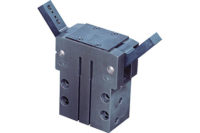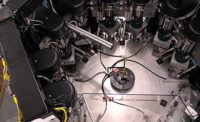At some point during a philosophy 101 class, college students learn about Aristotle’s belief that the best way to understand something is to break it down to the smallest components. For an increasing number of manufacturers and integrators, however, the best way to assemble a product is to use a machine built with modular automation components that quickly and easily fit together.
Several years ago, Zodiac Business Aircraft Interiors (formerly C & D Zodiac) began using extruded structural framing from Bosch Rexroth Corp. to streamline seat production at a plant in California. The company’s customers include every major airline and commercial aircraft manufacturer, including Embraer SA and Bombardier Aerospace. More than 1,000 passenger seats are produced at the plant every month.
Prior to streamlining production, Zodiac assembled its seats with a batch and queue system, where workers went from seat to seat to install parts. Today, seats move from station to station on wheeled carts that are made with Bosch Rexroth framing and other modular components. A fixture on the top of each cart holds the seat in place while it’s assembled. Converting to the continuous-flow line has increased plant production by nearly 200 percent.
Extruded framing is one of many modular components that benefit manufacturers and integrators. Also popular are linear slides, end-effectors, rotary units, valve manifolds, press kits, feeders and conveyors. The appeal of these components is simple: They allow design engineers to spend more time focused on optimizing assembly processes, rather than spending countless hours building each assembly machine from scratch.
More Than Just Semantics
Suppliers say that the word “modular” means different things to their customers. Some prefer the simple definition of standard or non-proprietary, meaning that like components from multiple suppliers are similar in design and interoperability.
Others consider modular to mean reconfigurable, which is a key performance benefit. Markus Walderich, group manager for automation at SCHUNK Inc., says his company’s modular components offer end-users the ability to make an almost infinite number of combinations.
“Today’s automation assembly equipment—be it a basic single-axis device or complex multiaxis system—relies heavily on standardization,” notes Walderich. “In fact, the smaller lot sizes and shorter product life cycles become, the greater the need for reconfigurability.”
These components have significantly increased in popularity over the last decade, even though suppliers have offered them since the early 1990s.
“They didn’t really take off until the current generation of design engineers demanded them to make their jobs easier,” explains Sean McBride, national sales manager at Afag Automation AG. “For decades, manufacturers were forced to build machines with non-modular components because they were all that was on the market. Now, suppliers are committed to making what’s better and easier for manufacturers.”
Chris Lupfer, assembly technologies product sales manager at Bosch Rexroth Corp., says that modular-component-based machines are essential for manufacturers because assembly line configurations need to be changed more frequently for different products. He says companies today often need to reconfigure a line every three to five years, whereas in the past the line stayed the same for 20 or 25 years.
Some suppliers offer functionally complementary product lines, enabling manufacturers to rely on a single source for the components they need. Frank Langro, director of marketing and product management at Festo Corp., says this can save the design engineer valuable time when researching and purchasing components.
“The more I can buy ready-to-install modular components and subassemblies, the less I have to build,” says David Goodenough, director of robotics and technology development at Edgewater Automation. Goodenough has been designing and building a wide range of custom automation equipment for the integrator since 2005. “Plus, if these components don’t perform as promised at any time, I hold the supplier accountable.”
What’s Popular
Among the most popular types of modular components are those used for transporting parts. McBride says manufacturers in several industries use Afag’s PEL linear transport modules in conjunction with high-speed feeding equipment and pick-and-place robots. The modules can transport workpieces to a designated location within a few tenths of a second. They are compact, easily programmable and have a maximum speed of
4.8 meters per second.
McBride says that medical device manufacturers use the modules on assembly machines for syringes, blood-sampling units and catheters. Automotive manufacturers use them on machines that assemble headlights, dashboard parts and more.
Components and subassemblies for material handling are popular as well. Afag’s electric actuators can be programmed to move along multiple axes and make multiple stops. Langro says that Festo’s subassemblies are often used by pharmaceutical labs and semiconductor manufacturers to precisely move materials.
These types of companies, as well as those that make consumer electronics, use Festo’s YXMx compact handling system for various desktop applications. According to Langro, the system’s components can be used to create gantry robots to perform screwdriving, dispensing, testing, soldering, gripping, and the opening and closing of containers. The system’s work area covers up to 700 millimeters on the X axis, 360 millimeters on the Y axis, and 75 or 125 millimeters on the Z axis. The CECC-X controller is for the PLC, motion and vision.
Item America LLC offers 25 different linear slide subassemblies. Each features a customizable linear slide, aluminum extrusion frame, couplings and all mechanical components (timing belt, roller guide, shaft and reverse unit). Philipp Herrmann, vice president of item, says the subassemblies are popular with manufacturers in locations with high labor costs or those that need precise automated processes, especially the United States, Canada and Europe.
A linear slide or rotary actuator is often the prime mover in a modular automation system. It is driven pneumatically or with electricity and can also provide secondary motion or rotate an end-effector with a wrist motion.
Pneumatic slides offer two, three or more positions, whereas electric slides provide almost infinite positioning, depending on the motor type and control package used to power the unit. The slides come in either of two configurations: saddle or carriage, or cantilever or thruster. With the former type, a load-carrying member moves between two end plates on a bearing system. The latter kind features a tool plate that supports an overhung load.
SCHUNK’s ELP linear slide is an electric, direct-drive unit with less moving parts than a pneumatic model. For example, the slide doesn’t require shock absorbers and is a maintenance-free module. The slide’s integrated controller automatically adjusts speed and acceleration depending on the load, which optimizes performance in all applications. Designed to be quickly set up and running, the slide is controlled via digital I/O. Preloaded roller guides without play ensure high performance in the toughest applications across different industries.
Actuators must be configured to produce the exact amount of required rotation, which can be output via a keyed shaft, a hub or a flat mounting surface. They also must be properly sized to handle the load and kinetic energy generated at the end of rotational travel. Some offer up to five positions for greater flexibility, and feature shock absorbers to increase their kinetic energy capability.
A gripper is the most common end-effector used in modular automation. It is pneumatic or electric powered, and can be small enough to handle tiny electrical components or large enough to lift engine blocks. Regardless of size, the gripper (and accompanying tooling) must be the correct type and size to ensure proper grasping of the part while withstanding dynamic loads associated with motion.
The gripper’s jaws can pivot or move at an angle or in a parallel motion. Manufacturers like parallel grippers because they provide consistent positioning of the workload, particularly when the part being handled has varying dimensions. The appeal of angular grippers is lower cost and the ability to provide a fairly wide jaw opening relative to the distance from the jaw pivot point.
Manufacturers also need to decide if they want the gripper to have synchronized or nonsynchronized jaws. Synchronized jaws ensure that the part is consistently placed in the same position. Nonsynchronized jaws move independently and compensate for the position of the part during gripping.
Loved by All (Industries)
When modular components first came onto the market, large automotive OEMs and tier 1s were the first users. Today, with the components being more cost-effective than ever, manufacturers of every size in every industry are benefitting from them.
One large pharmaceutical manufacturer uses Afag’s Aflex vibratory feeder with an integrated hopper on one side. The company installed a pick-and-place machine on the other side and a vision system above the hopper to help the machine accurately presort parts. Previously, presorting required three steps and took much longer to perform.
Two versions of Afag’s HLF linear feeder are available. The M model features a magnet drive and operates at 120 hertz, making it better suited for standard size automotive parts. The P model is equipped with a piezoelectric drive that produces fine vibration for small parts. Semiconductor manufacturers prefer the latter type when sorting filaments and other micro parts. Consumer electronics companies use it to sort small parts for printers and computers.
Some suppliers offer standard and one-off custom components or subassemblies. Festo, for example, recently built a special modular valve for a medical device manufacturer. Measuring 2-by-0.5 inch, the valve features piezo technology that enables it to accurately control how much oxygen is consumed in an oxygen delivery device. This portable unit is powered by batteries, and thanks to Festo’s valve, offers improved mobility for patients. It is now in serial production at a rate of tens of thousands annually.
“In emerging industries, there are often applications that require modular components not included in our standard line,” notes Walderich. “Often times, our custom components become standard in the future. Industries with more automation maturity, like automotive, experience the same cycle times as emerging industries, like food and agriculture, in terms of components becoming standardized.”
Herrmann says that medical, electronics and automotive manufacturers—as well as those that perform packaging—like the precision of item’s KRF linear slide subassembly. It features high-strength steel tracks integrated in the guide profile, and crisscrossed rollers that provide a high load-carrying capacity in a space-saving solution. The compact linear unit is a belt-driven slide capable of handling loads of up to 250 kilograms. Stroke lengths up to 6,000 millimeters are possible, with high positional accuracy (0.1 millimeter) at speeds up to 10 meters per second.
Manufacturers in industries as diverse as life sciences, aerospace and automotive use Bosch Rexroth’s EasyHandling platform to quickly design, build and implement a Cartesian robot. According to Richard Vaughn, automation engineering supervisor at Bosch Rexroth, the platform enables companies to build robots ranging from tabletop to pallet-handling units.
Standard features include durable extrusion framing, servo drives and the Open Core Engineering software interface. This interface permits enhanced access to the control core and allows the integration of smart devices into automation systems. It also allows for the creation of independent, real-time control functions, and the use of numerous programming languages, from simple (Excel) to complex (C++).
“If the workstation or assembly line to be built is quite complicated, I’ll contact the supplier for help,” concludes Goodenough. “For the most part, though, our customers’ specs are clear enough that we can confidently buy components from the suppliers and install them just fine.”









